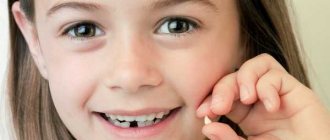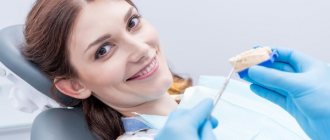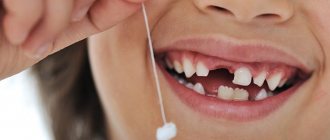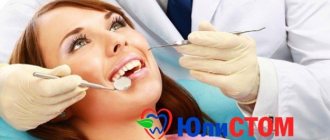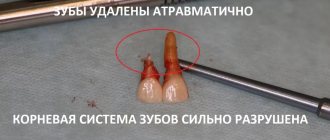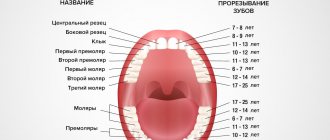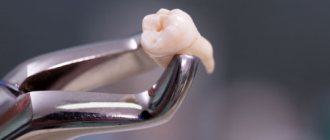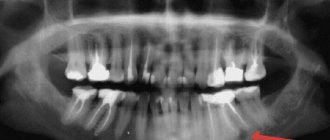A tooth bruise is a common injury that can go virtually unnoticed or lead to serious complications. This is due to the fact that after a blow, the position of the tooth does not change, and the periodontal tissue can suffer greatly. The consequences of a bruise depend on the force of impact. Significant damage can cause tooth loss. Since nerve endings and blood vessels are affected during a bruise, you should contact the dentist immediately, even if there are no external changes or painful sensations.
Symptoms
External signs will also differ depending on the strength of the impact. Externally, a bruise manifests itself with the following symptoms:
- The tooth hurts after a blow. Any mechanical injury leads to pain, but if it is intense and does not go away for a long time, severe injury can be suspected.
- The crown has darkened. This indicates that the blood vessels are damaged and hemorrhage has occurred in the soft tissue.
- Numbness of the face, swelling. These signs indicate severe damage to the nerve endings.
- Mobility of teeth after bruise. They begin to wobble, the gums swell.
Even if your teeth don’t hurt much after the blow, the pain goes away quickly and there are no other external manifestations, you should consult a dentist. It is possible to speak accurately about possible complications only after examination and x-rays.
Methods for treating blue gums
Treatment depends on the cause that caused the blue gum due to the appearance of a hematoma. It should be aimed simultaneously at reducing the focus of the bruise and eliminating the factor - facilitating teething, curing infection or inflammation, opening an abscess.
To alleviate the condition, if a child has hit or fallen, or has torn off and severely injured the gums, cooling compresses and painkillers are used. Warm or hot compresses are unacceptable at first, as they increase blood flow and increase the area of the hematoma on the gum.
Treatment of hematoma due to gum injury
If a child’s gums are blue due to a blow, injury, or bruise, immediately apply a cold compress for 10–15 minutes. As prescribed by the doctor, it is possible to apply ointments for better resorption of the bruise - Heparin and Troxerutin.
The duration of such treatment for a bruise is 5–7 days, then if the child’s symptoms and complaints persist or intensify, it is necessary to contact a dentist and pediatrician.
Painkillers
If there is a bruise on the gum due to contusion and its pain, it is not always possible to do without painkillers, available in the form of syrups, tablets, suppositories and gels for topical use. The choice of medication, dosage and application rules depend on the severity of the symptom, the age of the child, possible violations of tissue integrity and individual characteristics.
In pediatric practice, the following drugs are used for pain relief as prescribed by a specialist:
- Ibuprofen or Nurofen (suspension, tablets, suppositories);
- paracetamol-containing medications (Efferalgan, Paracetamol, Cefekon, Panadol - the same release forms);
- Kamistad Baby, Holisal, Dentinox, Leader in the form of gels.
For infections and inflammations that cause blue tissue, antiviral suppositories Viferon and Genferon are prescribed as an additional remedy. The second medication has an analgesic effect.
Help with teething
To relieve pain, eliminate the bluish area, and improve the child’s well-being, you can help in the following way.
- Use special teethers containing liquid that have a cooling and antipruritic effect, or chewing teethers. For the same purpose, you can use gauze soaked in a cool infusion of chamomile in the form of applications on the painful and damaged blue gum of a baby.
- Topically apply gels to the area that have an analgesic and antiseptic effect, recommended to facilitate teething. In children's practice, Cholisal, Kamistad Baby, Lident, Baby Doctor First Teeth are used.
- To reduce restlessness, tearfulness and capriciousness of the baby, relieve pain, inflammation of tissues, and improve sleep during teething, homeopathic drops Dantinorm baby are recommended. You can also calm the baby by placing it on the mother's breast if he is breastfed.
- To relieve fever, pain and other clinical manifestations of teething and blue gums, Viburkol suppositories are used. They are safe and used for very young children. Among the undesirable manifestations, diarrhea is noted in some cases.
Attention! If a child is bothered by an excessively high temperature, pain, severe swelling of tissues and redness or yellowing with pus, an infectious process may develop. In this case, it is necessary to immediately contact a pediatrician to prescribe urgent, comprehensive treatment.
If the blueness is large, the bruise and suppuration do not go away, and the child is unable to erupt a tooth, surgical treatment is resorted to. To do this, the area of blue or burgundy gums is anesthetized, the mucous membrane is dissected, and the hematoma and pus, if any, are removed. Finally, the wound is washed with antiseptic solutions and recommendations for further treatment and care are given.
Treatment of inflammatory gum diseases in children
To get rid of inflammatory and infectious processes, it is necessary to establish the type of disease that provoked it and eliminate them. For gingivitis the following are prescribed:
- rinsing with antibacterial and antiseptic solutions, if the child does not know how, then applications and wiping;
- application of gels with antimicrobial and antibacterial properties;
- choosing the right toothpaste and brush.
Gingivitis can be caused by insufficient, absent or poor-quality oral care. One of the treatment measures is to eliminate this factor by teaching the little patient the correct actions.
For stomatitis, antiseptics in the form of gels for local application and rinsing, painkillers, and regenerating medications are also used. Antibiotics can only be prescribed by a doctor.
How to treat bruised gums at home
One of the reasons for the appearance of a hematoma on the gum is that the child fell, tore off the mucous membrane and damaged it. In this case, for better healing, prevention or treatment of inflammation, rinsing with antiseptic solutions is necessary - Chlorhexidine, Rotocan, tincture of calendula, chamomile, sage, etc.
Medicines are prescribed in advanced cases, when in addition to bruising, high temperature, soreness of damaged tissue, and suppuration are a concern.
Hemorrhage and hematoma on a child’s gum can occur for various reasons: tooth decay, trauma, oral diseases. To eliminate the symptom, it is necessary to establish the provoking factor together with the doctor and follow his recommendations.
Bibliography
- P. I. Ivasenko - Emergency conditions in outpatient dental practice, M.: Medical book, 2009.
- Major M. Ash, Stanley J. Nelson - Wheeler's Dental Anatomy, Physiology and Occlusion - Saunders - 2002.
- Kuryakina I.V., Kutepova T.F. - Diseases, periodontal disease, N. Novgorod: NGMD, 2000.
- V. A. Zelensky, F. S. Mukhoramov. - Pediatric surgical dentistry and maxillofacial surgery, M.: GEOTAR-Media, 2008.
- Persin L.S., Elizarova V.M., Dyakova S.V. - Pediatric Dentistry, Medicine, 2006.
- Vinogradova T.F., Maksimova O.P., Melnichenko E.M. — Diseases of periodontal and oral mucosa in children, M., 1983.
- Ralph E. McDonald, David R. Avery, Jeffrey A. Dean - Dentistry For The Child And Adolescent - Mosby - 2004
Find a clinic
Causes
There are many reasons for a tooth bruise. The most common is a strong direct blow to the jaw. Athletes often receive such injuries; they are almost always the consequences of accidents. It is impossible not to notice it, since after a blow the front tooth hurts, and the pain is usually sharp.
There is another reason - the so-called chronic jaw injury. The peculiarity of such injuries is that they are insignificant in their impact, but a person is constantly exposed to them. Examples include some human habits: biting nails, holding a pen or pencil in the mouth, cracking nuts, etc. Under the influence of such seemingly insignificant factors, the enamel becomes thinner and microchips form on it. The result of these innocent habits is tooth loss.
Injury can also occur during dental procedures performed by an inexperienced dentist or using old equipment. Any violation of the treatment or removal technique can lead to damage to healthy tissue. That is why our clinic employs experienced, highly qualified specialists. We are responsible for the health of our patients.
Causes of suppuration
If you have purulent discharge from your gums, there is a pimple in which pus accumulates, you feel pain, your teeth ache, then you should not hesitate, but immediately go to the doctor. If you start a purulent inflammation that has formed in the gum, serious consequences can occur. All this can even lead to blood poisoning.
As for a purulent pimple, it can be of any size. For some, it may resemble a pea in shape, and sometimes it can reach the size of half a walnut. But it is worth knowing that you cannot judge the severity of the problem by the size of this pimple. If there is a purulent pimple and it is small, then if left untreated, it can increase significantly within a day.
Suppuration can occur for the following reasons:
- The gum was injured by a fragment of a tooth that was broken. A poor quality crown that hangs over the edge of the gum can also scratch the gums;
- hygiene procedures were performed using a very hard toothbrush;
- a man carelessly picked his teeth with a toothpick.
You should know and understand that every manipulation that relates to teeth must be carried out carefully and carefully so as not to touch the gums. If pus appears, a person must realize that there is already an inflammatory process. And it needs to be treated without delay.
Complications
What to do after a tooth injury? The answer is clear - contact your dentist immediately. Even if it seems to you that the injury was not severe, you do not experience pain, there is no bleeding. Not a single blow passes without leaving a trace on the body, and its consequences will sooner or later make themselves felt. A bruise can lead to various complications:
- Dying of the pulp. During a bruise, nerve endings are damaged, neighboring tissues gradually die, an inflammatory process develops, purulent formations and cysts form.
- Darkening of the crown. Occurs due to rupture of blood vessels. At first the enamel takes on a pink tint and then darkens. The crown tissues do not receive the necessary nutrients. Even if it is possible to maintain the integrity of the tooth, it will stand out in the row due to the changed color. Regular bleaching cannot remove darkening.
- Periodontal damage. In this case, the bruise leads to the development of periodontitis.
Children's bruises do not go away without a trace, so if your baby falls and hits himself, he needs to be shown to the dentist. A long-term consequence of such injury is abnormal growth of permanent teeth.
Dental injuries in children
1
Stay calm and calm the baby.
2
2. Examine the child for symptoms associated with a concussion (nausea, headache, bruises).
3
3. Try to find the knocked out tooth or its fragments.
4
4. Rinse the tooth with mineral water (still) and place it in a physiological solution of sodium chloride 0.9% (if you can immediately purchase it at the pharmacy), in milk or in still water.
5
5. Try to come to the dentist within 2 hours so that the doctors can carry out a series of manipulations and splint (strengthen) the tooth.
6
6. If it is not possible to go to the dentist on the same day, you must place the tooth in a 0.9% sodium chloride solution or milk and leave it in the refrigerator until you seek dental care (no more than 24 hours).
At the clinic, the dentist will sanitize the hole, clean it of blood clots and bone fragments. The tooth is depulped and then replanted (placed back into the socket). The next stage will be splinting for a period of 6-8 weeks. During this time, any mechanical impact on the replanted tooth should be excluded.
Incomplete tooth luxation
means that the tooth has changed its position (usually in the vestibulo-oral direction), but is still in the socket. In such cases, the tactics are as follows: under local anesthesia, the dentist fixes the tooth, subsequent splinting and canal treatment. If the correct position is not accepted after the acute phase, then it is possible to influence the dentition through a brace system.
Impacted dislocation
. Childhood trauma, in which, due to vertical traumatic impact, a deepening or so-called impaction of the tooth into the alveolus occurs with damage to periodontal tissue. The treatment tactics are identical to the previous case. An attempt should be made to return the permanent tooth to its place, splint it, and perform root canal treatment if necessary.
In the case of baby teeth, dentists often take a wait-and-see approach. Often the teeth return to their place on their own after some time. Replantation of any type of dislocation is impossible in cases where a significant amount of time has passed after the injury. Fixation of baby teeth is impossible to avoid damage to the rudiment and difficulty in its eruption. If for one reason or another it was not possible to save the tooth, implantation is performed after restoring the integrity of the bone tissue. In children, this manipulation is possible no earlier than 18 years of age.
Possible consequences
Moms and dads must remember that the rudiments of the molars suffer from injuries to temporary rudiments. In such permanent teeth, enamel develops poorly and hypoplasia develops. The germ may even die. Therefore, treatment of baby teeth in children should be carried out on time. If the pulp area is severely damaged, the tissues will gradually begin to die and become necrotic. Necrosis causes inflammation and discoloration of the crowns in a dark color. It happens quickly. After some time, cysts form on the damaged areas. To establish a diagnosis, doctors refer for an X-ray examination.
If a child's baby tooth has been displaced by an impact, it may become loose for several weeks. Even slight staggering may occur due to damage to the alveolar process. When mammary rudiments are not treated after injury, it causes irreversible consequences. Swelling and redness usually appear in the area where the main impact occurred. The hematoma can be pronounced, and can also be determined only during palpation. When you press it, the baby experiences discomfort and pain. A fracture of the alveolar process is expressed by pain when moving the jaws. If the ligaments are torn, pain is observed on the entire surface of the dental system.
What to do?
The main thing is never to heat the place that hurts. Once upon a time, grandmothers said that you need to bandage your cheek with a warm scarf, but you shouldn’t do this. Inflammation cannot be heated. If the temperature rises, the process becomes even stronger. If there is pus, you should apply a piece of ice to the area that hurts.
If the pus comes out of the gums, you shouldn’t think that everything is gone. Drug treatment is necessary to stop the process. But antibiotics must be prescribed by a doctor.


